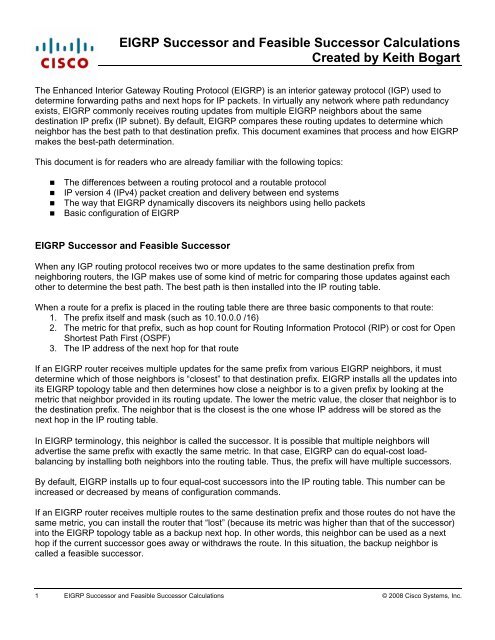EIGRP Successor and Feasible Successor Calculations Created by ...
EIGRP Successor and Feasible Successor Calculations Created by ...
EIGRP Successor and Feasible Successor Calculations Created by ...
Create successful ePaper yourself
Turn your PDF publications into a flip-book with our unique Google optimized e-Paper software.
<strong>EIGRP</strong> <strong>Successor</strong> <strong>and</strong> <strong>Feasible</strong> <strong>Successor</strong> <strong>Calculations</strong><br />
<strong>Created</strong> <strong>by</strong> Keith Bogart<br />
The Enhanced Interior Gateway Routing Protocol (<strong>EIGRP</strong>) is an interior gateway protocol (IGP) used to<br />
determine forwarding paths <strong>and</strong> next hops for IP packets. In virtually any network where path redundancy<br />
exists, <strong>EIGRP</strong> commonly receives routing updates from multiple <strong>EIGRP</strong> neighbors about the same<br />
destination IP prefix (IP subnet). By default, <strong>EIGRP</strong> compares these routing updates to determine which<br />
neighbor has the best path to that destination prefix. This document examines that process <strong>and</strong> how <strong>EIGRP</strong><br />
makes the best-path determination.<br />
This document is for readers who are already familiar with the following topics:<br />
The differences between a routing protocol <strong>and</strong> a routable protocol<br />
IP version 4 (IPv4) packet creation <strong>and</strong> delivery between end systems<br />
The way that <strong>EIGRP</strong> dynamically discovers its neighbors using hello packets<br />
Basic configuration of <strong>EIGRP</strong><br />
<strong>EIGRP</strong> <strong>Successor</strong> <strong>and</strong> <strong>Feasible</strong> <strong>Successor</strong><br />
When any IGP routing protocol receives two or more updates to the same destination prefix from<br />
neighboring routers, the IGP makes use of some kind of metric for comparing those updates against each<br />
other to determine the best path. The best path is then installed into the IP routing table.<br />
When a route for a prefix is placed in the routing table there are three basic components to that route:<br />
1. The prefix itself <strong>and</strong> mask (such as 10.10.0.0 /16)<br />
2. The metric for that prefix, such as hop count for Routing Information Protocol (RIP) or cost for Open<br />
Shortest Path First (OSPF)<br />
3. The IP address of the next hop for that route<br />
If an <strong>EIGRP</strong> router receives multiple updates for the same prefix from various <strong>EIGRP</strong> neighbors, it must<br />
determine which of those neighbors is “closest” to that destination prefix. <strong>EIGRP</strong> installs all the updates into<br />
its <strong>EIGRP</strong> topology table <strong>and</strong> then determines how close a neighbor is to a given prefix <strong>by</strong> looking at the<br />
metric that neighbor provided in its routing update. The lower the metric value, the closer that neighbor is to<br />
the destination prefix. The neighbor that is the closest is the one whose IP address will be stored as the<br />
next hop in the IP routing table.<br />
In <strong>EIGRP</strong> terminology, this neighbor is called the successor. It is possible that multiple neighbors will<br />
advertise the same prefix with exactly the same metric. In that case, <strong>EIGRP</strong> can do equal-cost loadbalancing<br />
<strong>by</strong> installing both neighbors into the routing table. Thus, the prefix will have multiple successors.<br />
By default, <strong>EIGRP</strong> installs up to four equal-cost successors into the IP routing table. This number can be<br />
increased or decreased <strong>by</strong> means of configuration comm<strong>and</strong>s.<br />
If an <strong>EIGRP</strong> router receives multiple routes to the same destination prefix <strong>and</strong> those routes do not have the<br />
same metric, you can install the router that “lost” (because its metric was higher than that of the successor)<br />
into the <strong>EIGRP</strong> topology table as a backup next hop. In other words, this neighbor can be used as a next<br />
hop if the current successor goes away or withdraws the route. In this situation, the backup neighbor is<br />
called a feasible successor.<br />
1 <strong>EIGRP</strong> <strong>Successor</strong> <strong>and</strong> <strong>Feasible</strong> <strong>Successor</strong> <strong>Calculations</strong> © 2008 Cisco Systems, Inc.
Just as an <strong>EIGRP</strong> router may have multiple equal-cost successors to a given prefix, it may also contain<br />
multiple feasible successors. However, just because a router advertises a route does not mean that the<br />
router necessarily qualifies as a feasible successor; it must first meet the feasibility condition (FC). The FC<br />
is described later in this paper.<br />
The value used for the IGP metric varies depending on which IGP is in use. RIP uses hop count. OSPF<br />
uses cost. <strong>EIGRP</strong> uses distance, which is a value derived from several vector metrics. Those vector metrics<br />
are b<strong>and</strong>width, delay, load, <strong>and</strong> reliability; however, b<strong>and</strong>width <strong>and</strong> delay are the only two factors used in<br />
the default calculation.<br />
When an interface on a router becomes active, metrics such as b<strong>and</strong>width <strong>and</strong> delay are automatically<br />
assigned to that interface, whether or not a routing protocol is in use. You can see these values <strong>by</strong> using the<br />
Cisco IOS comm<strong>and</strong> show interface, as shown in the following example.<br />
It is these same values that are used to derive the <strong>EIGRP</strong> distance for that directly connected network.<br />
2 <strong>EIGRP</strong> <strong>Successor</strong> <strong>and</strong> <strong>Feasible</strong> <strong>Successor</strong> <strong>Calculations</strong> © 2008 Cisco Systems, Inc.
Advertised Distance<br />
When an <strong>EIGRP</strong> router is directly connected to a network <strong>and</strong> must advertise that prefix to its neighbors, it<br />
must determine the “advertised distance” for that prefix. The advertised distance is the distance the local<br />
router perceives that prefix to be from itself. This is also sometimes called the reported distance.<br />
<strong>EIGRP</strong> uses (<strong>by</strong> default) the values of b<strong>and</strong>width (BW) <strong>and</strong> delay from the interface, <strong>and</strong> plugs those<br />
numbers into the following formula to derive the advertised distance of that directly connected network:<br />
The K values shown in the formula are simple multipliers <strong>and</strong> <strong>by</strong> default take on the following values:<br />
With the default K values shown above, the <strong>EIGRP</strong> formula ignores the last part of the equation (that uses<br />
reliability), <strong>and</strong> the portion of the equation using load drops out as well. This leaves the following as the<br />
default formula for determining the <strong>EIGRP</strong> distance of a prefix:<br />
3 <strong>EIGRP</strong> <strong>Successor</strong> <strong>and</strong> <strong>Feasible</strong> <strong>Successor</strong> <strong>Calculations</strong> © 2008 Cisco Systems, Inc.

















